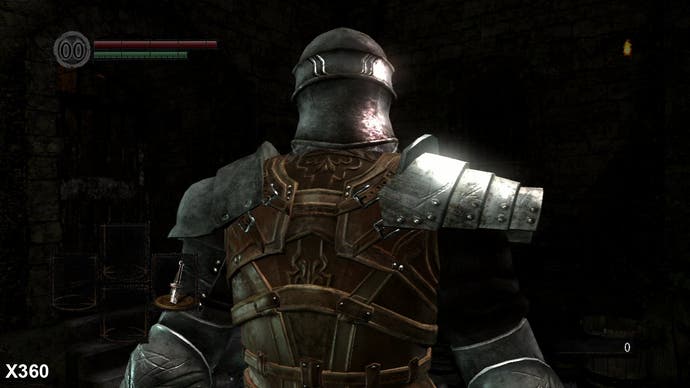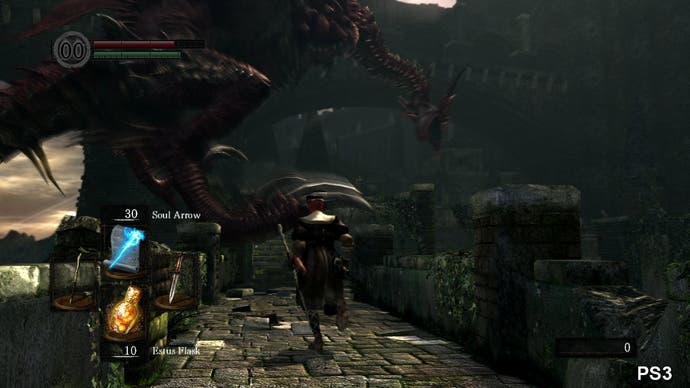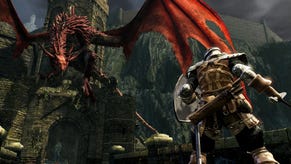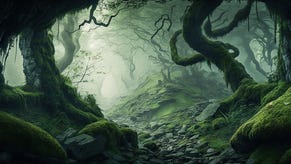Face-Off: Dark Souls
Soul survivor?
| - | Xbox 360 | PlayStation 3 |
|---|---|---|
| Disc Size | 4.0GB | 4.87GB |
| Install | 4.0GB (optional) | - |
| Surround Support | Dolby Digital | Dolby Digital, DTS, 5.1LPCM, 7.1LPCM |
Fantasy games are rarely so horrifying as Dark Souls can be, and it's a pleasure to see another take on the same visual references put forward by Demon's Souls just two years ago. Although the world of Boletaria has been exchanged for Lordran, much remains the same. The long bridges guarded by red wyverns and undead hoplites still show From Software's love of old Fighting Fantasy gamebooks, and the winding, eldritch castle passageways continue to succeed in baiting the reckless gallivant into an untimely end, while rewarding the more patient, methodical player.
A direct carbon copy of what worked before would have been disappointing though, and that's not precisely what Dark Souls offers. As described in Oli Welsh's Eurogamer review, the sparse smattering of bonfires (bespoke check-points) across its seamlessly open world pushes the game's structure into Metroid-vania territory. This change in pace occasionally affords Dark Souls time to show off some environments that reveal an uncharacteristic beauty, particularly after the tutorial section, where you're transported to a flooded, mossy shrine ruin decorated by soft rays of light leaking out from swaying branches.
Not only is this an unexpected moment of calm from a series that predicates itself on holding one's nerve, but it's also an immediate example of the advances made in the latest iteration of Sony's PhyreEngine since its use in Demon's Souls. Developed internally at its own R&D department and offered for free to studios licensed with Sony, the engine has been advertised as a multi-platform middleware solution that puts especial emphasis on deferred rendering through multi-core CPUs. Additionally, it has been promoted with bullet-points such as PhysX/Havok support, level streaming, and post-processing techniques such as glow and motion blur, almost all of which have been used in practical ways throughout Dark Souls.
Of course, despite its origin, it's surprising to find that these very same tools are apparently being used to run the 360 version of the game as well, and with no apparent technical (or legal) penalty. A trend could well be forming here: other developers, such as Codemasters, have previously opted to use the engine to drive their multi-platform projects effectively.
Clearly, this approach has benefited Dark Souls too. Those with an eye for discrepancies in image quality between the PS3 and 360 titles will find little to complain about. As you'll see from the Face-Off video above, and not to mention our supplementary Dark Souls comparison gallery, picking out differences between the like-for-like frames here is very much an exercise in splitting hairs. Many of the more obvious visual variations in the introductory cut-scenes, such as the angles of the lighting on the back of our Warrior's steel armour, are purely incidental, and simply come as a result of the rolling clouds being in differing states.
Given that the number of spawning points across the entire game can be counted on two hands, capturing identical sequences of actual gameplay proved difficult, although from the examples we found, the results were largely similar to the cut-scenes. The blunt conclusion is that, in terms of raw technical proficiency, everything from the motion blur on the crashing wyvern to the particle effects around lit bonfires are tantamount. Similarly, the art assets, including bump-mapped textures on castle walls and instances of "fur" texturing on bosses - both of which carry a pleasing increase in detail over Demon's Souls' - are a precise match on both consoles.




Each version runs at a native 1024x720, with v-sync engaged. The decision to decrease the resolution from Demon's Souls' 1280x720 is more than made up for by the additional coat of 2x multi-sample anti-aliasing (MSAA) lavished upon the overall image. This clears up the rough edges that blighted the look of its AA-deprived predecessor, previously evident on a character's illuminated weaponry and armour while running against dark, labyrinthine backdrops. That being said, since the muted greens and browns that comprise Dark Souls' environments rarely allow for many harsh contrasts, the improvements don't extend too much further.
On top of this, it appears a post-processing filter running on the PS3 version is affecting the clarity of certain text elements, such as the Estus Flask notification in the bottom-left of the screen. As with most filters working indiscriminately across the whole frame, text and HUD elements often get caught in the line of fire, although it really only seems to have affected the text in this case. On very close zoom, this filter is also the likely cause of a very subtle softening to the definition of distant textures not evident on 360. These are nitpicks more than anything, and are only evident when closely scrutinized next to images of the rival version.









